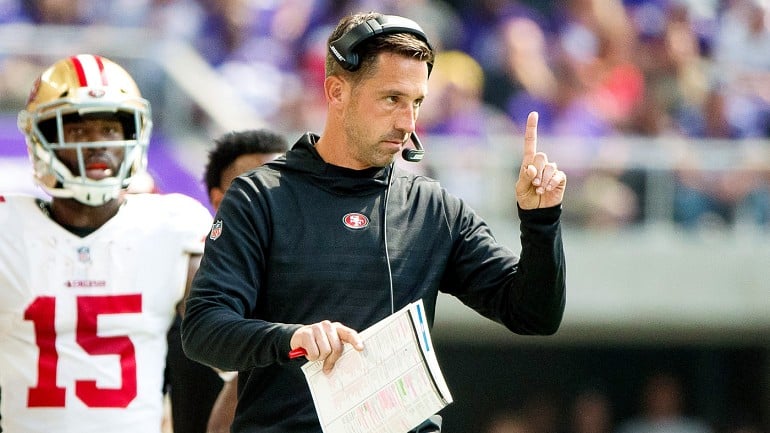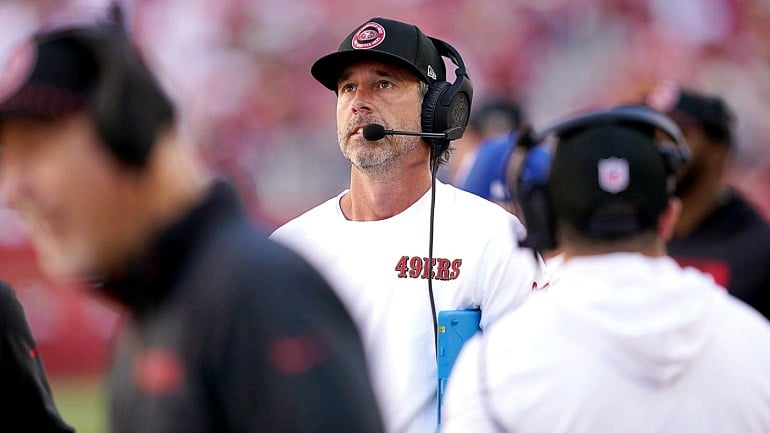In the first part of this series, we laid out the theoretical background for different types of offensive operations and different types of attacks within those operations. Today, we'll look at 2 more types of attacks as well as some different tactics that further explain how head coach Kyle Shanahan's offense gains an advantage.
Briefly, within the attack phase of an operation, there are several different ways a combat unit gains an advantage over its enemy. In the last article, we described two key plays on the opening drive against the Cardinals, two variations of a fullback screen, that sought to take advantage of a defense's pursuit angles and aggression. On the next play, Shanahan shows that after two successful attacks, it becomes imperative to exploit what you've learned from the previous situations to inform the next attack (intelligence gathering).
Types of attack continued
Exploitation
After the initial attack, whatever type it may be, the ground commander, or head coach in this case, must use what knowledge he's gained from the previous attacks to exploit the already-confused defense. During the exploitation phase:
"Exploitation disorganizes the enemy in depth usually following a successful attack. The exploitation extends the initial success of the attack by preventing the enemy from disengaging, withdrawing, and re-establishing an effective defense."
With the Cardinals disoriented and reeling from the previous plays (at the end of part one), Shanahan dials up yet another screen pass to exploit the confusion.
Two plays and a false start penalty later, the 49ers would take an early 7-0 nothing lead. Juszczyk motions back to the back field to a "near left bunch" formation, leaving a two receiver bunch to the right. Shanahan makes it hard to decipher what exactly is going on in a given a play, whether that be through motions, misdirection, personnel formations, blocking assignments, or all of the above.
Building off the two plays and concepts above, Shanahan exploits the relative confusion of the Cardinals defense keying on Juszczyk and determined to eliminate his role in the play. At the snap, Beathard starts his drop back like he's going to pass but then executes a hard play fake. The offensive line drops back in a pass set as well as he executes the fake. Next, Breida fake stalk-blocks on defensive end Benson Mayowa (No. 91). Mayowa side steps Breida thinking he's going to pass block, opening a passing lane for the shovel toss from Beathard to Breida. In the chaos of a defense reacting to the multiple movements by the offense, center Weston Richburg (No. 58) and right tackle Mike McGlinchey (No. 69) release downfield, perfectly timed to Breida catching the pass and turning up toward the end zone.
Beathard easily completes the pass as it's one he doesn't have to throw through or around a defender. It's just a quick toss to the running back. Breida does the rest and runs right behind his blockers into the endzone.
Reconnaissance in force
Another type of way coaches or commanders can exploit areas of weakness to their advantage is through a "reconnaissance in force." A reconnaissance in force is a "deliberate attack to obtain information and to locate and test enemy dispositions, strengths, and reactions."
Two plays against the Detroit Lions in Week Two last season show how this theory works.

On the second drive of the game, the offense ripped off a 9-yard gain with Matt Breida on a toss crack play called "18" or "19 TRUCK."
Quarterback Jimmy Garoppolo motioned fullback Kyle Juszczyk (No. 44) out of the back field I formation and out wide. The motion showed the defense was in a zone coverage when cornerback Darius Slay (No. 23) bumped out over Juszczyk out wide. The motion leaves five defenders on the left side of the box from the center over to the in-line receivers, a total of five offensive blockers. Breida takes the snap behind a pulling Joe Staley (no. 74) out on the edge as receiver Pierre Garçon cracks down on the defensive end and receiver Dante Pettis (no. 18) works to the second level safety.
The play had a built in back side slant run by tight end George Kittle (No. 85) that was used to "recon" information: the Lions defense did not cover him and fast-flowed to the run action. Breida rips off 9-yards behind a nice lead by left tackle Joe Staley (No. 77).
The defensive structure revealed information about how the Lions would next play the toss crack if they saw the same formation. It is here where the theory states that "while the primary purpose...is to gain information, the commander must be prepared to exploit opportunity." Shanahan used the information from the play above to exploit the defense on two plays later.
Two plays later, the 49ers offense comes right back to the play above but flips the formation and assignments. The play call is the same toss crack play as above but this time they are running it to the right from the far left hash with the same personnel.
The Lions, not to be fooled again, this time notice the same formation and throw an extra defender to that side of the formation to stuff the toss play. This time they line up with six defenders from the center over to the offense's right to give them some leverage.
Using the intelligence gathered from the first play, Kittle is going to run right into the void the defense left for him as a result of the defense fast-flowing to the run action again. Kittle goes out on the quick slant/pop route over the middle into the void left by linebacker Jarad Davis (No. 40) as they chase the toss play. This springs Kittle open by about three steps and leaves an easy toss and catch for Garoppolo.
However, Garoppolo rushes the pass and delivers the throw over Kittle's outstretched hands. What would have been an easy 15- or 20-yard gain falls as incomplete but shows the way in which Shanahan's offense works in sequence to play off a defense's tendencies. Not all missions are successful.
Tactics
Speed in combat - Being faster
Within Marine Corps warfighting, the tactics doctrine provides more useful tools for understanding how modern offenses attack defenses or can attack defenses. Using examples from the Raiders game, we can see the effect that speed and spread offense attacks have in gaining a competitive advantage.
In the Marine Corps:
"We use speed to gain the initiative and advantage over the enemy ...On our approach to the enemy, speed in movement reduces his reaction time. When we are going through him or around him, it changes the situation faster than he can react. Once we are past him, it makes his reaction irrelevant. In all three cases, speed impacts on the enemy, especially his mind, causing fear, indecision, and helplessness. Remember, attacking the enemy's mind is a central tenet of maneuver warfare."
Whereas in combat, the act of speed and "being fast" can provide considerable advantages on the battlefield, so too can being fast on the football field enable an offense to take advantage of the disarray and chaos of a defense being outmatched and out-maneuvered.
The 49ers spent most of the Raiders game in 11 personnel (one running back, one tight end, three receivers) with two of their fastest receivers on the field most of the night (Richie James and Marquise Goodwin) as well as George Kittle (on some occasions faster than anyone on the field).

The 49ers start out in a "gun near trips left" and motion to a two-by-two with James as the motion man. The Raiders are in a cover two man shell with the safeties outside the hash. The defensive backs are in press coverage, man-to-man, and the motion confirms this as James' defender follows him to the other side. The 49ers are running a double slant concept to the right called "LION."
The pre-snap defense begins to tip its hand and shows signs of an impending blitz from the nickel defender as the far deep safety begins to cheat over the far slot receiver. Meanwhile, the near safety begins to cheat toward the middle of the field, revealing a cover one shell. James' defender takes outside leverage on him to keep him from running down the seam with no safety help.
Nothing hits quicker in the passing game than a quick slant over the middle. Mullens scans the field just before the snap and sees the shift in the defense and the blitz coming from the left as the middle linebacker creeps up into the box. As he catches the snap, he sees the void in the middle of the field and he immediately looks right and fires over the middle on the quick slant to James. James takes it up field for a 53-yard gain.
Three plays later on the same drive, the 49ers flip the formation and run the same exact play to Richie James again.
The Raiders see the same motion from trips to a two-by-two formation and the same 11 personnel grouping on the field on a second-and-8. They're initially showing a cover two shell again but this time they walk a blitzing defender down into the box on the side that James motions to. Shanahan and Mullens again get the look they want. The Raiders rush seven against Mullens, leaving the coverage one-on-one in a cover zero look against the four receivers. The Raiders again tip their hand and show Mullens that he has a very good one-on-one inside match-up on the quick slant behind the blitz off the edge.
James gives a quick outside move and gets the defender to open just slightly to the outside before he cuts back inside on the slant. The quick move gives him some separation and gets Mullens enough room to fit a pass into him in stride. However, James turned up field to run before securing the pass and dropped what would have probably been a touchdown.
Asymmetry
In Marine Corps doctrine, asymmetrical warfare is a form of "gaining advantage." In gaining an advantage, "we strive to gain an advantage over our adversary by exploiting every aspect of a situation to help us to achieve victory, not by overpowering him with our own strength." Fighting asymmetrically means "gaining advantage through imbalance, applying strength against an enemy weakness."
In football, nowhere is this more visible than in an offense creating favorable match-ups against weaker defenders or taking advantage of inferior pass coverage schemes. An offense might run one play, and come back to it later knowing how the defense is going to react, and will hit another route on the play based on how the defense over-pursues what it thinks will be the ball carrier.
For this one, we dip into the NFL Gamepass archives and go back to 2016 when Shanahan was the offensive coordinator for the Falcons. In Week Five that season, there is a sequence of plays that show how Shanahan uses the principles of asymmetry and imbalance to create favorable match-ups.
The primary way Shanahan creates imbalance is by keeping his offense in a primarily running game dominant personnel grouping like 12 personnel (one back, two tight ends) or 21 personnel (two backs, one tight end). Doing so keeps a defense in its base personnel defense. In this case, the Broncos, in both plays, stay in a traditional 3-4 defense with four linebackers.

With the Falcons in 12 personnel, the Broncos defense stays in its base 3-4 defense playing a cover 5 shell (2 deep with man coverage underneath, also known as cover 2 man). Quarterback Matt Ryan motions running back Tevin Coleman (now with the 49ers!) out of the back field on an "H LT" motion that puts Coleman in the inside slot of the formation. Shanahan's play call is a 4-verticals concept called "dancer zorro."
At the snap, Coleman runs right by linebacker Brandon Marshall down the seam and quarterback Matt Ryan drops in a pass between the linebacker and safety down the seam and Coleman does the rest by finishing with a touchdown.

On another play late in the game in the fourth quarter, Matt Ryan found Coleman down the sideline for a big gain. The Falcons used a double shift first with tight end Austin Hooper on a "Y-trade" motion and then with Coleman on an "H RT" motion. The motions revealed that the Broncos were man-to-man under a single high safety, what then Broncos defensive coordinator Wade Phillips calls "cover 1 dog" (above). The motions dictate the matchup they wanted.

Coleman shifted to the slot inside where linebacker Todd Davis (No. 51) was matched on Coleman. The passing concept to the right side was what Shanahan calls the "smack seam" concept (slot fade with a curl/hitch route). Ryan made a big-time throw with the pocket collapsing for a 49-yard gain.
Using running backs in the passing game dictated advantageous match-ups against what was then one of the league's top defenses and a Broncos team coming off a Super Bowl victory the previous season. Forcing the linebackers to play in space against much faster offensive skill guys proved to be a solid plan of attack.
Outlook
The concepts and theory of modern warfare are easily applicable to the game of football and Shanahan is a master of preparation and planning. We can see the intricate ways that he schemes week after week to attack certain weaknesses in a given defensive scheme and how the lessons of combat translate to the football field. Through the use of motions, shifts, and misdirection in combination with the running and passing game, it makes for a unique study of an NFL offense and new way of looking at how coaches prepare their game plans.
Shanahan is among the league's best play designers and his scheme will now be in use by at least four teams this coming season, and probably a half-dozen more in the next few years as coaches are poached from the tree by other teams looking to capture the strategic value and operationally sound playbook structure that his scheme offers. It's even crazier to think that we have not seen the full potential of the offense and what he can unleash, making the hype surrounding 2019 as loud as it's ever been since Levi's Stadium opened.











